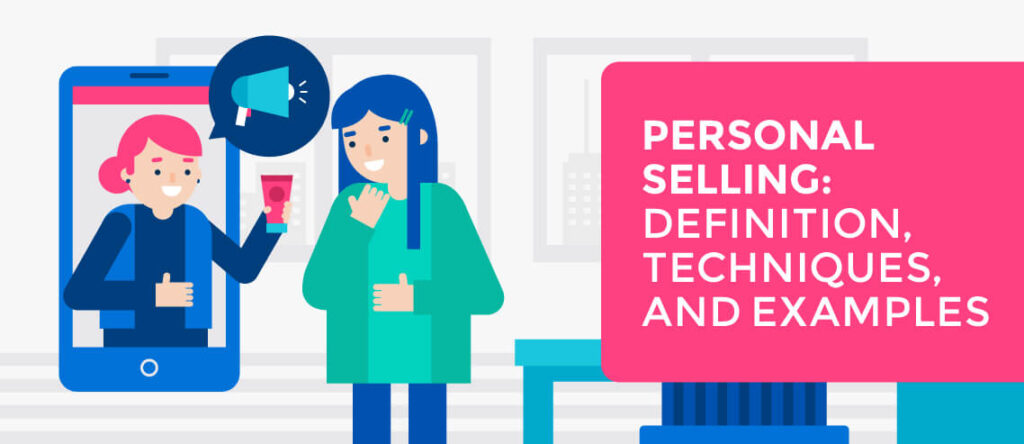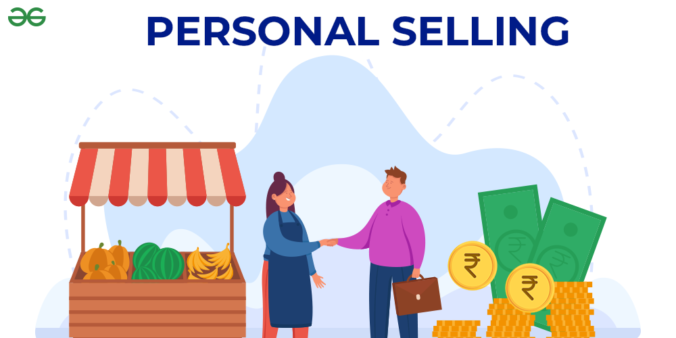Table of Contents

A salesperson used to accept orders back in the day. He demonstrates his worth. He waits for a command. After that, he is paid.
He never tries to lead, assist, or influence the customers. However, the current definition of salesmanship differs significantly from the traditional one.
The approach to a modern notion is imaginative. He develops needs and then transforms them into desires.
The biggest issue that salespeople face is customer happiness. Both the buyer and the seller need to make a profit.
The salesperson assists the consumer in purchasing items that meet his needs.
The salesperson encourages clients to act by appealing to their emotions. That’s when Personal Selling Comes into Play.
PERSONAL SELLING
Personal selling is a promotional tactic in which one party (for example, a salesman) employs skills and strategies to create personal relationships with another party (for example, individuals engaged in a purchase decision) that benefit both sides.
Most of the time, the salesperson’s “value” is achieved via the financial rewards of the sale, whereas the customer’s “value” is gained through the advantages derived from using the product.
Personal selling, on the other hand, isn’t necessarily about convincing a consumer to buy anything.
Because selling entails human contact, this promotional strategy is frequently conducted through face-to-face meetings or telephone conversations, while emerging technologies allow interaction to take place over the Internet, such as through video conferencing or text messaging (e.g., online chat).
Definition of Personal Selling
A specific instance of personal selling is the one-on-one or face-to-face encounter between a salesman and a potential consumer. Personal selling is a subset of the larger selling process.
In personal selling, a salesman or representative interacts directly with a single person or a small group of people in order to promote and sell a good, service, or concept.
Here are a few definitions of personal selling by notable authors:
- Philip Kotler and Gary Armstrong: “Personal selling involves a face-to-face interaction with one or more prospective purchasers for the purpose of making presentations, answering questions, and procuring orders.”
- Stanton, Etzel, and Walker: “Personal selling consists of the two-way flow of personal communication between a salesperson and a prospective customer that is paid for by the firm.”
- William J. Stanton: “Personal selling is an oral presentation in conversation with one or more prospective purchasers for the purpose of making sales.”
- Michael R. Solomon: “Personal selling refers to the two-way flow of communication between a buyer and a seller, often in a face-to-face encounter, designed to influence a person’s or a group’s purchase decision.”
Definition & Meaning of Selling
The act of transferring products, services, or ideas for cash or other desirable considerations is referred to as selling.
It entails a sequence of acts and interactions between a seller (person or group) and a prospective buyer or customer with the objective of persuading the buyer to make a purchase or take a desired action.
Presentation of the goods, negotiation, persuasion, and contract closure are typical selling actions.
Understanding a customer’s requirements and preferences, developing a relationship, offering information or solutions that satisfy those needs, overcoming objections or fears, and eventually executing a transaction are frequently necessary for effective selling.
The ultimate goal of selling is to establish a situation where both the vendor and the customer are content with the outcome of the trade.
It is an essential component of business and commerce, contributing significantly to the creation of income and the maintenance of economic activity.
- Philip Kotler: A renowned marketing author, Philip Kotler, defines selling as “the process by which a seller communicates with potential buyers in an effort to influence them to purchase a product or service.”
- Zig Ziglar: A well-known sales trainer and author, Zig Ziglar, describes selling as “the transference of trust.”
- Brian Tracy: Sales expert Brian Tracy defines selling as “the art of convincing a prospect that the product or service you have to offer will solve a problem or satisfy a need.”
- Jeffrey Gitomer: Author Jeffrey Gitomer characterizes selling as “earning the right, privilege, and honor to serve your customer.”
- Neil Rackham: In his book “SPIN Selling,” Neil Rackham defines selling as “a process of helping buyers reach a mutually beneficial agreement.”
Examples of Personal Selling
Personal selling is direct communication between a salesman and a prospective client. Here are a few instances of personal selling in different settings:
1.Retail Sales: When you enter a retail store, a salesperson may approach you to assist you in finding items, make suggestions, and help you make decisions about what to buy.
They interact with you directly to improve your shopping experience and boost your chances of making a purchase.
2. Real estate: When showing homes to prospective purchasers, real estate agents participate in personal selling.
They tell potential buyers about the homes, respond to their inquiries, and assist them as they make one of the most important financial choices of their life.
3. Financial Services: Financial advisers meet with customers one-on-one to learn about their financial objectives, evaluate their requirements, and suggest investment strategies, insurance plans, or retirement plans that are suitable for their specific circumstances.
4. Business-to-Business (B2B) Sales: Salespeople in the B2B industry frequently participate in personal selling.
For instance, a sales team from a software business may meet with executives from another company to discuss a specific contract while showcasing the advantages of their software products.
5. Automobile Sales: Personal selling is a key strategy for auto dealerships. Salespeople set up test drives, go over financing alternatives, help buyers choose the best vehicle, and haggle costs.
6. Door-to-Door Sales: Although it is becoming less frequent, some businesses still employ door-to-door salesmen to promote goods and services including home security systems, vacuum cleaners, and educational resources.
To present their presentations, these salesmen go to certain residences.
7. Multi-level marketing (MLM), commonly referred to as network marketing, mainly focuses on personal selling.
Independent distributors work one-on-one with their network to sell items and enlist new members.
8. Consulting Services: When management consultants, IT consultants, and other experts meet with customers to discuss their unique company difficulties and provide solutions, they are engaging in personal selling.
9. High-end luxury firms frequently use personal marketing in their boutique boutiques when selling premium goods.
Sales employees respond to the individual interests of each customer, give knowledgeable assistance, and deliver a personalized shopping experience.
10. Fundraising: When requesting donations, non-profit organizations and charity frequently employ personal selling strategies.
Professionals in fundraising meet with prospective contributors to discuss the organization’s goals and the value of their donations.
Concept of Personal Selling
- It’s a component of the product mix.
- It’s a one-on-one (face-to-face, phone, or internet chat) presentation aimed at closing sales and strengthening connections.
- This is an oral presentation.
- Salesmanship.
- Perceive and convince potential customers.
The effort of sales people go far beyond simply making transactions, they also include following:
- Benefits of the product are explained.
- Demonstrating how to use the product properly.
- Customers are being educated about the new product.
- Responding to concerns and answering inquiries.
- Organizing and carrying out point-of-sale promotions.
- Organizing the buying terms.
- Following up on the sale to make sure the consumer is happy.
- Establishing a relationship with the purchasers.
- To develop marketing strategy, data about the market and competitors is collected.

This is not Personal Sales, It is Digital Sales
Personal selling is mostly used when:
- Geographically, in a few industries, or among a few significant clients, the market is concentrated.
- The product is expensive per unit, highly technical, or requires demonstration.
- As with insurance or investments, the product must be tailored to the specific needs of the consumer.
- The product is still in its early stages of development.
- The organisation does not have sufficient funds for effective advertising.
Features of Personal Selling
- More targeted communication directed at one or more individuals.
- Buyer preferences, convictions, and behaviours are all effective.
- The cost per individual is significant, and it is the most costly advertising tactic available.
- Consumers are more affected.
- Gives you quick feedback.
- Allow the marketer to make fast changes to the messaging in order to increase communication.
- The buyer has a strong desire to listen and respond.
- To establish a sales team, long-term commitments are required.
Techniques of Personal Selling / Techniques to close Sales / Personal Selling Strategies
In order to interact with potential consumers, establish rapport, and eventually persuade them to make a purchase or perform a desired action, successful personal selling requires a combination of tactics and talents. The following are some crucial personal selling methods:
1.Prospecting : The first phase in personal selling is prospecting, which involves finding prospective clients who are likely to be interested in your good or service.
To do this, you need to do research, generate leads, and compile a list of possible customers.
2. Preparation: Be prepared by doing extensive background research on a possibility before speaking with them.
You can successfully modify your pitch if you are aware of their particular circumstances.
3. Approach: It’s important to make a good first impression on a prospect.
You should establish rapport, give a good first impression, and define your visit or conversation’s goal in straightforward terms.
4. Presentation: This is where you highlight the qualities and advantages of your item or service.
Emphasize the ways in which your offer meets the needs and resolves the issues of the prospect. If necessary, include illustrations, examples, or other help.
5. Handling Objections: Be ready for the prospect to raise questions or objections. In response to complaints, respond coolly and empathetically, offering answers or details that allay their concerns.
6. Closing the Sale: The ultimate objective of personal selling is to obtain the prospect’s commitment. To lead the discussion to a conclusion, use closing methods.
Assumptive closes like “Would you like this in red or blue?” and trial closes like “Would you like to try it for a week?” are two examples.
7. Follow-Up: To ensure client satisfaction and establish a long-lasting relationship, contact the consumer after the transaction or the initial conversation.
This might entail offering after-sale assistance, promoting further goods or services, or requesting recommendations.
8. Active Listening: Pay close attention to what the prospect is saying by actively listening.
them to talk more about their wants and worries by asking open-ended inquiries. This indicates your sincere concern for their predicament.
9. Empathy: Demonstrate empathy for the prospect’s difficulties and worries. Building rapport and trust via this.
10. Flexibility: Adjust your strategy as necessary. Match your communication and pitch to the prospect’s preferences and personality.
11. Confidence: Self-confidence is crucial, as is self-assurance in your goods or services.
The prospect feels trusted, which increases their propensity to take your advice.
12. Product Knowledge: Know all there is to know about the goods or services you are selling.
This enables you to confidently respond to inquiries and strategically position your service.
13. Telling stories: Discuss case studies or successes involving your goods or services.
Inspiring and relatable stories can help potential customers see the advantages.
14. Building Trust: In personal selling, establishing trust is essential.
Building and sustaining trust depends on your interactions being conducted with honesty, integrity, and consistency.
15. Time management: Use your time wisely and rank prospects according to how likely they are to convert.
Do not waste too much time on prospects who are unlikely to make a purchase.
16. Resilience: Rejection and disappointments are frequent occurrences in personal selling.
Develop resilience to recover from setbacks and have an optimistic outlook.
To fit various sales circumstances and industries, these approaches may be blended and adjusted.
A combination of persuasion, relationship-building, and a thorough grasp of the client’s requirements and motives is frequently required for successful personal selling.
Advantages of personal selling
- Because personal selling is a face-to-face activity, consumers receive a high level of personal attention.
- The sales pitch may be tailored to the customer’s requirements.
- Because the sales process is two-way, the sales staff is able to answer directly and quickly to the customer’s queries and concerns.
- Personal selling is an effective approach to convey vast volumes of technical or other complicated manufacturing data.
- Frequent interactions between salespeople and customers allow for the development of strong long-term connections.

Disadvantages of Personal Selling
- It is a somewhat pricey means of selling. It is necessary to have high capital expenses.
- Furthermore, it is a very time-consuming procedure. To be effective in personal selling, you’ll need a huge sales staff.
- The salesperson’s training is likewise time-consuming and expensive.
- And only a small number of people can benefit from the procedure. It does not cover a large demographic, unlike television or radio advertisements.
Fundamentals of Successful Personal Selling
- Salespeople must be more adaptable; they must personalise their presentations to the specific demands and behaviours of each consumer.
- He must be capable of discussing product benefits and answering client queries.
- He has to be honest.
- He must act in a trustworthy manner.
- You and the customer’s personalities must be comparable, as well as the commodity’s interests and aspirations.
- The salesperson must determine whether or not the individual or his prospect has the financial means to pay for the product.
Objectives of Personal Selling

Personal selling is used to meet the five objectives of promotion in the following ways:
- Building Product Awareness
Customers must be educated on new product offers, which is a frequent responsibility for salespeople, especially in commercial sectors.
However, in consumer markets, personal selling is equally useful for raising awareness.
Personal selling is a useful strategy for exposing consumers to new items as a result of word-of-mouth marketing.
- Creating Interest
Personal selling is a natural way to attract clients to try a product for the first time since it involves person-to-person conversation.
In reality, generating interest and increasing product awareness go hand in hand, and salespeople may often achieve both goals at the initial meeting with a new customer.
When salespeople engage clients, a substantial portion of the interaction revolves around product information.
Brochures, research papers, computer programmes, and a variety of other types of informative material are provided by marketing businesses to their sales employees.
- Stimulating Demand
The most crucial goal of personal selling is to persuade clients to buy something.
When salespeople provide extensive coverage of the selling process utilised to obtain client orders, they achieve this.
- Reinforcing the Brand
The majority of personal selling is to develop long-term connections with consumers.
A good connection with a consumer can only be developed over time and necessitates constant contact.
Meeting with clients on a frequent basis allows salespeople to explain their firm’s goods more than once, allowing customers to have a better understanding of what the company has to offer.
Types of Personal Selling
In the business there are two types of personal selling activities
- Inside selling
- Outside selling
- Inside selling
It has to do with retail shops. This category includes salespeople who work in storefronts and salespeople who work for catalogue merchants and receive phone orders.
Telephone order takers at manufacturers and distributors are also included, with the majority of them taking routine orders from current clients over the phone.
- Outside selling
It has to do with shopping malls. Salespeople who operate in storefronts and salespeople who work for catalogue merchants and take phone orders fall under this category.
Manufacturers and distributors’ telephone order takers are also included, with the bulk of them handling routine orders from current customers over the phone.
Other Related Topics
- Sales Presentation
- Sales Forecasting
- Sales Quota
- Sales Management
- Sales Territories
- Salesman – Types & Functions
- Buying Motives – Types & Stages
- Market Research
- What is Salesmanship? – Full Concept
- To Sell Is Human: Review & Summary – Quick Read
- The Psychology of Selling – Quick Read
- Book Insights & Review: “How to Win Friends and Influence People”
- World Most Selling Salesmanship Books| You Must Buy
- The Most Essential Knowledge for a Salesman
- Personal Selling: Full Concept In Detail
- The Essential Qualities & Skills for a Successful Salesman


